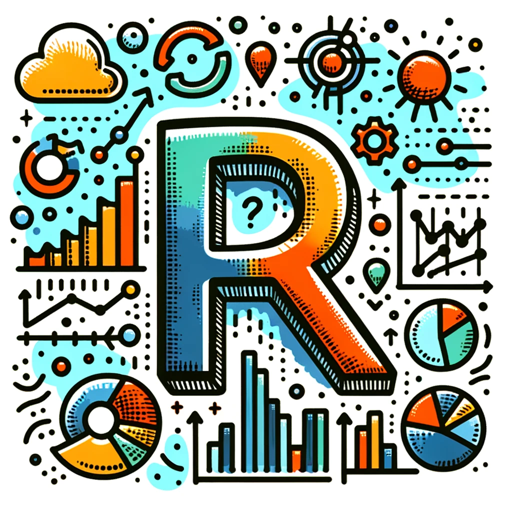📈 Linear Regression Analysis with R-R linear regression guide
AI-powered linear regression in R
Guide me through importing data for linear regression.
How do I handle missing values in my dataset?
What's the best way to fit a linear model in R?
How can I interpret the coefficients of my linear model?
Related Tools
Load More
Statistic & Data Analyst
Statistic and Data Analyst assistent

R coding - Advanced AI Assistant
Generates, explains, & optimizes R code

Advanced R Code and Statistical Consultant
The Most Advanced GPT for Statistics and R Code

Analysis with R
An expert in data analysis using the R programming language.

Regression Pro
Modeling made easy

R Guru
Expert in R for data science, statistical analysis, machine learning and deep learning
20.0 / 5 (200 votes)
Introduction to Linear Regression Analysis with R
Linear Regression Analysis with R is designed to facilitate the comprehensive understanding and application of linear regression techniques using the R programming language. Linear regression is a fundamental statistical method used to model the relationship between a dependent variable and one or more independent variables. It is widely used for predictive analysis, trend forecasting, and inferential statistics. In R, this involves functions and packages that allow for data cleaning, model fitting, diagnostics, and visualization. By providing a robust framework for these activities, Linear Regression Analysis with R ensures that users can perform detailed statistical analysis, validate their models, and interpret the results effectively.

Main Functions of Linear Regression Analysis with R
Data Import and Cleaning
Example
Using functions like read.csv() for importing data and na.omit() for handling missing values.
Scenario
A researcher importing a dataset of housing prices and cleaning it by removing rows with missing data before performing analysis.
Model Fitting
Example
Using the lm() function to fit a linear model.
Scenario
An economist fitting a linear model to predict GDP growth based on various economic indicators.
Model Validation
Example
Using functions like summary() to interpret R^2 and RMSE, and plot() for diagnostic plots.
Scenario
A data scientist validating a sales prediction model by checking the R^2 value and plotting residuals to ensure homoscedasticity.
Visualization
Example
Using ggplot2 for creating scatter plots and regression lines.
Scenario
A marketing analyst visualizing the relationship between advertising spend and sales revenue with a scatter plot and regression line.
Model Diagnostics
Example
Using the vif() function from the car package to check for multicollinearity.
Scenario
An academic checking the variance inflation factor (VIF) to ensure that the independent variables in their regression model are not highly collinear.
Ideal Users of Linear Regression Analysis with R
Researchers and Academics
Researchers and academics who require robust statistical tools for hypothesis testing, data analysis, and publication-quality visualizations. They benefit from the extensive libraries and community support available in R for conducting detailed regression analysis.
Data Scientists and Analysts
Data scientists and analysts who need to build predictive models, validate their accuracy, and derive insights from data. They benefit from R's powerful modeling functions and its capacity to handle large datasets efficiently.
Economists and Financial Analysts
Economists and financial analysts who need to forecast economic trends, analyze financial data, and build econometric models. They benefit from R's statistical packages that are specifically tailored for econometric analysis.

Guidelines for Using 📈 Linear Regression Analysis with R
Visit aichatonline.org for a free trial without login, also no need for ChatGPT Plus.
Access the tool directly from the website without any registration requirements.
Prepare Your Dataset
Ensure your data is in a clean and suitable format, typically in a CSV file. Handle missing values and outliers appropriately.
Import and Load Data in R
Use R functions like read.csv() to import your dataset. Explore the data using functions like summary() and head() to understand its structure.
Fit the Linear Model
Use the lm() function in R to fit your linear regression model. Specify the formula and data parameters accordingly.
Validate and Interpret the Model
Check key metrics like R-squared and RMSE. Validate the model using techniques like train-test split or cross-validation, and interpret the results to ensure the model's reliability.
Try other advanced and practical GPTs
⭐️ Customize Your Art Prompt ⭐️
AI-powered customizable art prompt generator

Stream & Chill España
AI-powered streaming search and recommendations for Spain.

Stream & Chill UK
AI-powered streaming guide for the UK

AI Voice Prompt Script Builder
AI-Powered Voice Prompt Creation

Mia AI, your AI Life Coach
AI-powered life coaching for personal growth.
NunnaGPT
Your friendly AI-powered assistant
MJ v6 Prompt Helper
AI-powered prompts for creative image generation

Creative Thinker
Unlock creativity with AI-powered insights

Your Havening Mentor
AI-Powered Emotional Well-Being Guide

Image Explainer
AI-powered insights into your images

Artistic Muse
AI-powered art creation tool for everyone.

Smarter Image Analysis 👁️
AI-Powered Image Insights

- Data Analysis
- Academic Research
- Predictive Modeling
- Business Forecasting
- Statistical Learning
Q&A About 📈 Linear Regression Analysis with R
What is linear regression?
Linear regression is a statistical method for modeling the relationship between a dependent variable and one or more independent variables. It helps in understanding how changes in the independent variables affect the dependent variable.
How do I handle missing values in my dataset?
You can handle missing values by either removing the rows with missing data or imputing the missing values using methods like mean, median, or more sophisticated techniques like k-nearest neighbors imputation.
What is the purpose of the lm() function in R?
The lm() function in R is used to fit linear models. It takes a formula and a data frame as arguments and returns an object containing the model's coefficients, residuals, and other relevant statistics.
How can I check for multicollinearity in my linear regression model?
Multicollinearity can be checked using the Variance Inflation Factor (VIF). A VIF value greater than 10 indicates high multicollinearity, which may require corrective measures like removing or combining variables.
What are some common methods for validating a linear regression model?
Common methods for validating a linear regression model include train-test split, cross-validation, and assessing residual plots. These techniques help ensure the model's predictive performance and generalizability.